A Ramble in Bromham in 1879

Bromham Bridge September 2007
The following article, part of a series of rambles around different Bedfordshire parishes, appeared in The Bedfordshire Times on 21st June 1879.
Between my visit to Bromham Bridge a week or two ago, and the recent ramble to Bromham which I am about to describe, a wonderful growth had taken place in the vegetation, wild and cultivated, of the locality. The hedges on the Bedford side of Bromham Bridge surprised me by their number of interesting plants. Besides the crowds of pale lilac-tinted geranium blossoms, and the masses of speedwell, which are general enough, I found both the large white campion and the bladder campion; while the two bryonies - black and white – the wild clematis, the hop, the woody nightshade, were all climbing the bushes together, and sometimes forming tangled masses in which two or three of these plants were intertwined. Of course, they are not all of them yet in flower, but the woody nightshade is beginning to hang forth its pendent clusters of purple and orange blossoms. The clematis, like many other plants, has more than one English name, and is known as “travellers joy”, or “old man’s beard”, or, again, as “maiden’s bower”. The origin of each name can at different seasons be easily understood when the plant grows as luxuriantly as it does on the Bromham-road. The traveller, especially if he be a pedestrian “rambler”, is certainly gladdened when he sees and smells as he journeys along the abundant and perfumed blossoms of the clematis in the late summer; and the graceful form and sweet fragrance of the climbing plant make it very appropriate as a constituent of the greenery of a maiden’s bower. And then in the dying autumn the feathery awns of the seeds give to the hedges on which the long, frail branches hang the hoary look of a greybeard.
But I must leave the clematis growing higher and thicker in the hedge, and step on towards the long level bridge of twenty-six arches, which stretches like a viaduct rather than a bridge, all across the broad meadows of the Ouse. This old structure is plain enough, and certainly has no architectural pretensions: it simply lifts the road above the floods and the river, and leaves passages beneath for the floods and the river to find their way to the sea. Yet it is a striking object in the landscape, and at once arrests the attention and arouses the interest of the stranger. Green meadows and green trees are sometimes too tame when not relieved by features that break the monotony of the scene. This old bridge breaks the monotony without introducing a discord. It also affords a line of elevated positions from which the wayfarer can look up and down the valley, and from that vantage ground can enjoy the quiet beauty of the spot. I confess that the valley looks prettiest when the water covers it and converts the broad meadows into a quiet lake. At present, since the water has retired to the ordinary channel, and has left the grass dirty and ragged, the visitor had better station himself near the Bromham end of the bridge, and leaning on the wall that looks down the river, contemplate, as long as he has time or inclination to do so, the charming grouping of the trees and water, firm land, and islands, where the natural bed of the river spreads out after leaving the bridge, and where the water loses itself at a not far distance in a maze of ash trees, elms and willows. The picture is good enough to form the material background against which to dream some very pleasant dreams.
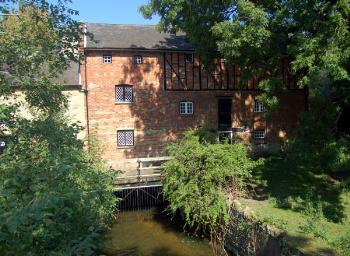
Bromham Mill August 2007
Turning round to the mill above the bridge, I find myself involuntarily murmuring the first line of a favourite German song, which is well-known in an English form, but the English words of which, being a translation, do not exactly reproduce the essence of the original.
“In einem kühlen Grunde”
Are words which express for me just the sentiment that lies in my mind associated with such a spot. I am not so sentimental as to forget that, even in the country, life is not essentially more idyllic than it is in the town: but who can entirely escape a stirring of aesthetic emotions in presence of one of those water-mills which steam has not defiled, and which we came upon suddenly, nestling as if half asleep by the edge of a wood or against a cluster of trees, and keeping “watch and ward” over the cool meadows – the “kühler Grund” of the song – that lie quite asleep beneath it?

The Miller's House September 2007
I shall not stay to talk about the remains of the chapel on Bromham Bridge, which are said to be still traceable in the miller’s house. The temptation to enlarge upon the relics of the past is one which the “Rambler” must resist sufficiently to avoid converting his paper into an archaeological catalogue. Moreover, are not all these details written at large in Mr. Harvey’s “History of the Willey Hundred”, and in other works of that character?
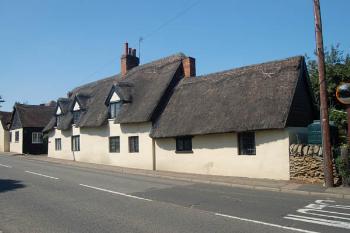
The Old Smithy August 2007
But I ask the reader to pass with me the village smithy just above the miller’s house, to enter the field path on the right, and to accompany me through the Park to the main part of the village of Bromham or Bruneham, Before we dip into the willowy bottom from the field of buttercups in which we first find ourselves, we must stay a second or two to admire the park’s trees before us, with shapes and tints arranged as if by an artist for a great picture. Skirting the bottom, like a line of natural fringing thrown around the larger trees to hide the junction of the meadows and the park, are white willows just now in their softest tint of grey-green. Above and beyond them rise the park trees messed in picturesque groups, and still retaining the last shades of the different tones of colour which marked the early growth of the leaves. At the bottom of the field, the ground through which the rough causeway leads to the yet rougher bridge is still too dirty with the recent floods to tempt one to stay: but in hurrying past, the quick observer will be arrested by the singularly compound character of the foliage of some of the half-rotten willows. I am well aware, of course, that the taking root of seeds in the rotting trunks of old trees is by no means a rare phenomenon; but I do not remember ever noticing so many parasitic seedlings on one tree as I found here. On one willow not far from the little wooden bridge, there are now flourishing the ash, the sycamore, and the elder: on another close by, is a large growth of hazel: and on another a large growth of ash. Perhaps the low-lying damp position has caused the willows to rot prematurely, and has thus made them good soil for weeds.
![Bromham Hall in 1924 [Z160/195]](/CommunityHistories/Bromham/Bromhamimages/Z160-195 Bromham Hall in 1924_350x254.jpg)
Bromham Hall in 1924 [Z160/195]
Bromham Park and its position close to the Ouse, together with the fact that it is the ancestral property of the Dynevor family, very naturally led my thoughts far away to the Welsh seat of the Dynevors. Pleasant “rambles” of mine in the old park and among the ivy-grown ruins of Dynevor Castle at Llandeilo, are not so far away in the past as to have caused the scenes to fade away from my memory. There also the park overlooks a river – the Towy – and one of the pleasantest valleys to be found in our island. The residents of Bromham Hall can boast that the trees of the English park are of as fine proportions as those at Dynevor Castle: but in other respects the two seats afford strong contrasts, notwithstanding their similarity of position. The Dynevor Park looks down from a precipitous timber-clothed hill upon the sweet vale of Towy, with its almost equally precipitous hills opposite; while Bromham Park rises from the Ouse bed with only a gentle rise. The bridge at Llandeilo is of one magnificent span, and indeed ranks among the finest structures of the kind to be found in the country; the bridge at Bromham is equally remarkable in another direction – in the possession of an unusual number of small arches. Both parks are charming spots: in the English one there is rural retirement and quiet pastoral beauty; in the Welsh one the beauty is of the wilder and more romantic kind naturally belonging to the district – a district of picturesque ranges of billowy hills, rising here and there into veritable mountain peaks, and intersected by the most charming valleys.
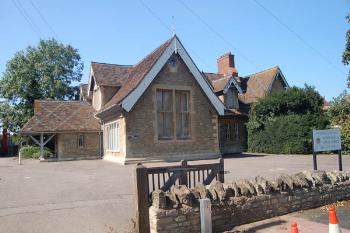
The former Saint Owen's School August 2007
It is difficult to dwell in detail upon villages like Bromham, where the property is divided between the owner of the manor and the Church. In such villages the cottages are for the most part little more than outbuildings of the hall or appendages to the park. They cannot fairly be put in competition with villages of an ordinary character. At Bromham one finds – and expects to do so – exquisitely neat little grounds of well-kept cottages, and a school and school-house very much superior to the ordinary character of village schools. This handsome block of buildings bears date 1861, and on the same wall as the date are the initials S. R. T. and E. M. R. T., standing respectively for Selina Rice-Trevor (Countess of Longford) and Elianore Mary Rice-Trevor, the present holder of the Hall. The school was built at the expense of these two ladies, the latter of whom still bears a large part of the annual cost, and also spends a considerable sum of money yearly in furnishing clothes to the children. Some red-cloaked girls, crossing a field as I was going to the church, gave me an opportunity of seeing the dress provided to the girls. I was unfortunate in calling at the school when to one was at home, but a window stood conveniently open, and I hope I was not guilty of unpardonable rudeness in standing for a time inspecting the interior through the open window. The fittings are everything that can be desired, and the interior has a very light, cheerful, and comfortable appearance. No cost has been spared in furnishing the school with requisite materials. I could see a good harmonium not far from the master’s desk, and I could hear the sober ticking of the school clock, like the spirit of order and punctuality keeping guard over the otherwise silent premises. Near the chief door the main buildings is cut by a transverse roof, under one gable of which is a good class-room divided from the middle space by a curtain. On the outside the other gable has on its barge-board the words “Those that seek me early shall find me”, so carved that at first the letters appear to be nothing more than a scroll ornament of the barge-board. The school is under the care of Mr. Thomas Warner, and Mrs. Warner superintends the sewing lessons of the girls. One of the last lessons given to the children of the day on which I made my inspection through the window must have been a drawing lesson on the black board, for a well sketched drawing of a saucepan with a long handle still remained undisturbed on the board. I learnt in the village that before the erection of the present school, the children were taught in what is now a group of cottages nearer to the Green.
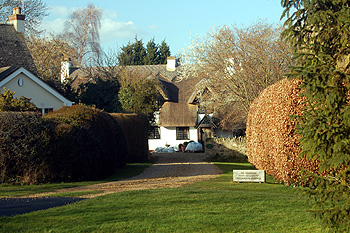
Greenwood Cottage - 14 The Green March 2012
Passing by the Green, where the male youth were at cricket, and where an ancient pump stands conspicuously under the shade of some trees, I went on to the spring that flows into a little stone reservoir on the left hand side of the road. Bromham is happily well supplied with excellent spring water, of which there is not only enough but to spare. From the spring to the church is only five minutes’ walk across a field.
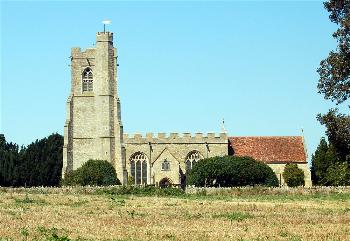
The church from the south August 2007
Here the visitor feels that he is really not only in the park, but in a part of the Hall Garden. The graveyard has all the care of a private shrubbery bestowed upon it, and the result is such as to pay for the trouble. I know not which side of the church to prefer, in the matter of picturesqueness: whether the north side from the field, with a foreground made up of a fine solitary Scotch fir in the centre and the large elms on either side; or the south side more closely shut in by large elms, and with the massive tower robed in ivy nearly to the top. The yard is adorned with garden shrubs and flowers, and the paths all have the very effective border of ivy which is generally seen only in the gardens of large houses. Ivy has taken possession of the greater part of the exterior of the church, both north and south. The general features of the church are Perpendicular. There are so many interesting details about the building that I must check my hand, and mention only the chief features.

The south porch August 2007
There are north and south porches, each having a room over, approached by stone steps outside. The room over the north porch was once used for school purposes, but is now the room in which the parish meetings are held. In the room over the south porch is an old library, which I have not inspected, but which is said to contain some curiosities interesting to bibliomaniacs. On the outside is a stone slab, bearing the following inscription:
THIS SMALL LIBRARY WAS
FOUNDED & FREELY GIVEN
FOR THE USE OF THE MINISTER
& THE PARISH OF BROMHAM
BY THOMAS LORD TREVOR
IN THE YEAR 1740
NO BOOK TO BE TAKEN OUT
WITHOUT LEAVE OF THE
MINISTER OR LORD OF
THE MANNOR
On the western jamb of the window between the south porch and the tower have been cut the following initials and dates: I. O. 1792; S. N. 1794. It seems uncertain whether these inscriptions were made by persons who have repaired the building or whether they are memorials of burials, or whether they are merely the work of idle visitors.
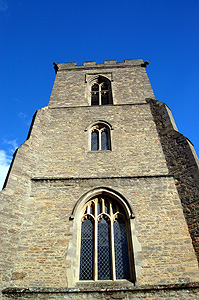
The west tower March 2012
The tower is a massive structure, having a turret-staircase on the south-east angle. To the large gargoyles which project from the four angles are attached at present some withered oak boughs, placed there on the 29th of May [Oak Apple Day]. Six bells occupy the bell-loft, bearing dates respectively, first and second 1739; third 1826; fourth 1686; fifth 1852; and sixth, 1686. The interior of the tower below the bell-loft is open to the nave, and is used by the Sunday School children, the bell ropes hanging over the forms. The centre of the bell-loft floor contains a large circular trap-door, through which the bells have been raised into the loft. A large old font stands in the middle of the nave; and against a pier facing the north door is fixed a very ancient alms-box, still used. The church shows abundant traces, both outside and in, of the extensive repairs and restoration which were made in 1868. In the nave the benches, the pulpit and the lectern are of carved oak. In the chancel, the stalls are also of carved oak, with poppy-heads bearing human faces, in imitation of the poppy-heads on the ancient stall ends which now form part of the prayer desk. In the south wall, behind the pulpit, is the door of the staircase leading through the wall into the rood loft that was taken away when the restoration was carried out. The upper doorway in the wall above the pulpit is closed with white stone, in which is a narrow opening in the shape of a cross. The appointments of the altar-place are very neat and simple. A reredos in the wall is made of white and red stones. Over the tables are the letters I. N. R. I.; on the north is the monogram I. H. S., and on the south the monogram composed of the Greek letters Ch. and R. On the north wall of the altar-place is a niche which was either a locker for alms, or a credence. It now contains at its back a tablet with the following inscription: "This chancel was rebuilt by the Hon. Elianore Mary Rice-Trevor in the year of our Lord 1868". Over the niche is a large cross in red stone inserted in the wall. On the south side of the altar-place is a piscine in the angle of the wall and the jamb of the window, and opening to the two sides with a shaft at the angle. In 1868 a mortuary chapel was added to the north side of the chancel by the late Lord Dynevor. The coloured lights of the window are filled with a number of subjects suggested partly by words from the New Testament. Six of the subjects are based on the words: "I was an hungered, and ye gave me meat; I was thirsty, and ye gave me drink; I was a stranger, and ye took me in; naked, and ye clothed me; I was sick, and ye visited me; I was in prison, and ye came unto me". A corresponding six are explained by the legends under each respectively: "Counselling the doubtful", "Teaching the Ignorant", "Forgiving Offences", "Converting the Heathen", "Warning Sinners", "Comforting the Afflicted".
![The interior after the fire of 1906 [Z49/415]](/CommunityHistories/Bromham/Bromhamimages/Z49-415 after the fire of 1906_350x222.jpg)
The interior after the fire of 1906 [Z49/415]
But I must pass by with a mere mention the organ-chamber and its harmonium, the armour that hangs in the chancel and the nave, the rich tombs that stand in the chapel and the aisle, the fine brasses in the chancel floor, and a number of other features which the visitor will find worth noting if he has time. If the reader goes to Bromham Church on a fine day in June, he will be charmed with sights and sounds of the place, which is a very paradise of birds; and I can only hope he will stay to see the old tower and its trees, as I did, in the golden light of a summer sunset.